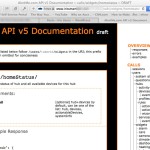When Iris first launched back in 2012, one of the initial statements from Lowes that it was their goal to open the platform for 3rd party developers. After 18 months, like some Iris accessories, it’s safe to stay this promise has yet to be delivered too. I could devote an entire article full of supposition and speculation as to the reasons why Lowes has not opened the platform to developers, but I believe that for now, the motivating reason is to maintain control of the platform.
The approach Lowes is taking with Iris is not entirely different than what Apple is doing with their ecosystem of hardware and software. This control of hardware and software and how they fit together should arguably result in cutting edge features, functionality and ultimately, a better user experience. Whether you like Apple or not, Apple understands the need for a positive user experience and has learned to effectively execute in that area. The Iris ecosystem, much like Apple’s, attempts to re-create that in the home automation space, but with one key difference; Apple never claims theirs to be open.
Iris’ open platform offers consumers wide range of connected home devices for peace of mind wherever they are and whenever they want it – lowes.com
It is no secret that Lowes did not invent the Iris platform, rather they used existing technologies such as Zigbee and Z-Wave, and partnered with Alertme.com to build the hub and backend systems which tie everything together. As with Apple, Lowes took existing technologies and connected them together to provide a solution aimed squarely at the average user.
Back to the original question of why hasn’t Lowes opened up the platform? The answer, which only Lowes management can truly provide, is certainly not for a lack of capability. AlertMe.com, the creator of the Iris backend, already provides an API to licensees of their technology. In poking around the many Iris servers that compose the Iris live and development systems, I found several instances of API documentation published on those servers, open for all to see, if you know where to look. So there is an API after all, complete with documentation and examples, but does it work?
The answer is a resounding “yes”. In less than an hour I was able to log into the Iris system using a little PHP web scripting code. In addition, I was able to arm and disarm the alarm and set the various system modes (HOME, AWAY, NIGHT, VACATION). Clearly, the framework has been developed and is already being used in the Iris mobile apps. The possibilities of 3rd party development are exciting; imagine a desktop Iris app, or Iris Dashboard on your PC, or even integration to IFTTT for exciting control opportunities.
It is up to Lowes to decice when, or even if, to open up the platform for 3rd party developers. I can only hope that Lowes will chose the path of innovation and do what is best for their customers.
Would you like to see more 3rd party innovation, such as alternative apps for Iris? Leave your comment below.


Not really anything special, I just rather see the admins quickly add the functions and products we ask for in a timely matter. No saying we are adding something, and then a year later its still not there.
It would be nice to see the platform open up. It would allow for a development community similar to that which SmartThings as built. The SmartThings community has already built integrations for popular items such as Philips Hue, IFTTT, WeMo, Sonos and much much more.
As much as I like my Iris, I’m losing faith in the Lowes’ ability to grow the platform and keep up with the pace of technology. Between the outages at the end of last year, the promotion of devices that are still labelled as “coming soon” and the lack of integration with 3rd party products….I may have to cut my loses and give an alternative product a try.
Wonderful site I’ve seen thus far! Is there any way you could share some of this API information you’ve found, I am a Senior Web Developer who focuses on the LAMP stack. I would love to get something a little more complex written up, I am also looking to integrate Iris functionality into my Pebble smart watch. Hopefully we can share some knowledge!
I figured out how to do some of this stuff tonight so I figured I would share:
If you go to https://api.irissmarthome.com/webapi/v2 you will see a link showing you some examples. Click this link.
Included here is what I believe to be a carbon copy of the alertme.com API examples. I downloaded all the Python files, but I am sure you can do the next step in the Javascript version as well.
Anyways. So in the Python files there is a file called webapi.py. Open this file up and search for alertme.com and change the URL to irissmarthome.com. Now all the scripts in the example work.
Happy programming!
Josh, thanks for this. I’m a developer looking for a way to replace the Cloud Iris server with my own home web server run on Raspberry Pi. If you know of any bloggers out there who have done this (I found http://www.desert-home.com, still checking this out) please let me know!
thanks
Really cool, having access to the API could provide an alternate way to interact with Iris. Maybe add a couple magic rules based on other Z-Way enabled devices, and possibly bridging the gaps between some devices that are currently showing up as “Unknown” when paired with the Iris Hub.
I think Iris should continue to be easy, but especially for premium users, it should also have some more advanced capabilities. I bet Lowes would find out that they have a community of developers that are more then happy to tinker to make Iris better for everyone, and in so doing increase interest and adoption.
I had a call today with Iris support, and learned a lot about the Hub, that when you put it to pairing mode, you do not need it connected to power or network to finish pairing. This allows you to bring the hub closer to the devices that are being pared or re-pared with iris. One you here the beep you can simply plug in the hub back into power and network and continue the process online. During this I received e-mails and texts letting me know that the hub has lost power, and when power was restored. So as long as internet connectivity is not broken first we should know when power is lost to a building.
I’ll be purchasing a Verizon USB 760, for my second hub which I’ll use to monitor a rental while it is empty for a couple months. I figured $10-20 a month is well worth the piece of mind when I can’t be there 100% of the time. I’ll let you know if I run into issues paying only $20-30 instead of through Lowes for $70
Well this is a little late response. But a year and a half a go I reverse engineered their complete API (of the devices I had). I released a Windows Store app to fully control Iris. Short story Lowe’s CIO contacted me and shut me down. So open API I’m not so sure it’s ever coming. I am now writing an Amazon Echo control application for voice control of Iris. I’ve contacted all my old contacts at AlertMe and Lowe’s and they are all gone, because I’d like to get their permission to do this. So no idea if they will approve. But if anyone want’s the library SDK (it’s in C# .net) for Iris let me know I can make it publicly available (FYI, I need to do a little work on it as it’s a out of date, and they did a few security things I need to adjust for).
I’ve looked at doing something in C#/.NET as well. I’d be very interested in seeing what you have done. My work was essentially replacing the Iris hub with my own code. Unfortunately, I still used the Iris back-end to do the control. That is, my code would log in to Iris, then send the appropriate commands to make stuff happen. My testing was using a Smart Plug. I’m happy to share that code if you’re interested. Of course, the “Holy Grail” here would be to be able to dispense with the entire back-end and control the stuff directly. One way of accomplishing this would be to do the control via the Iris hub, eliminating the back-end. The nice thing about this would be freeing the developer from the details of dealing with each individual device.
Has anyone looked into, or have any idea as to what it might take to develop a local server instance to control the v1 hubs. Now that they are being unceremoniously axed by Lowe’s, I wonder if we might be able to root them and obtain local control with them.